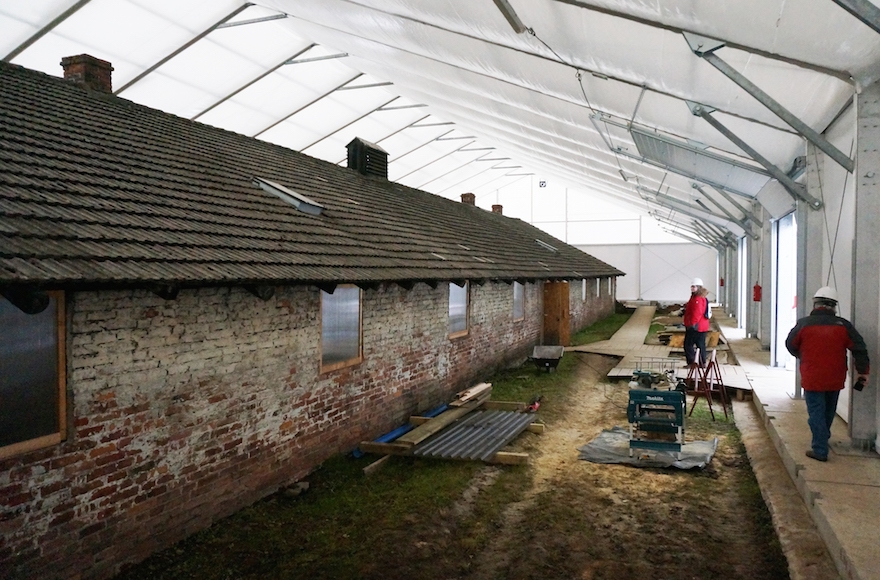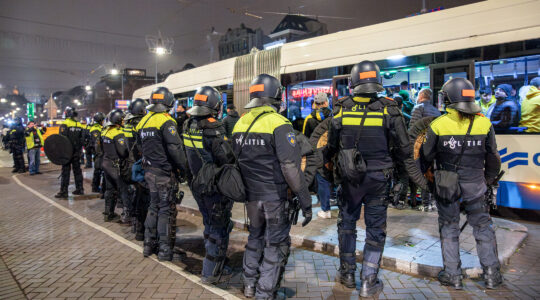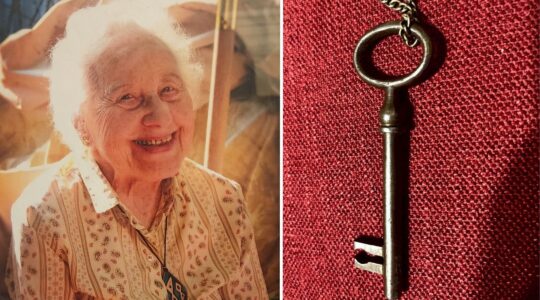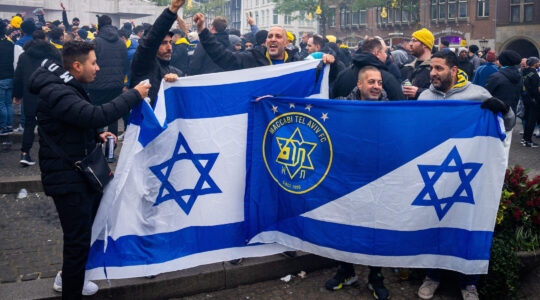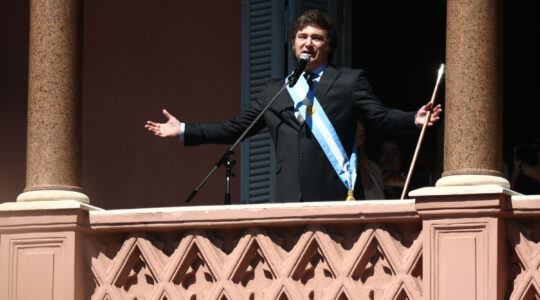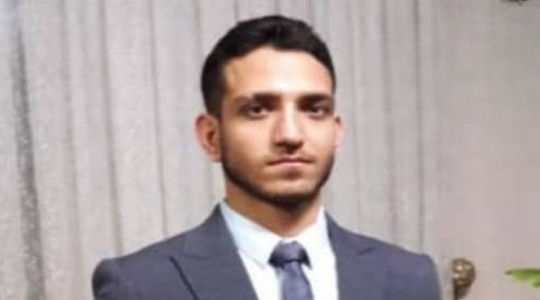OSWIECIM, Poland (JTA) — I did a shameful thing on my first visit 20 years ago to the former Nazi death camp of Auschwitz-Birkenau.
In a guestbook outside an Auschwitz museum exhibit featuring information on 70,000 Polish non-Jews who were murdered here, I downplayed the significance of their deaths by writing: “Your pain is no credential here, it’s just the shadow of my wound.”
Those words — a quote from a Leonard Cohen song that I abused as a high school student from Israel while touring the camp that my grandmother had survived — resurfaced in my consciousness last month on my latest visit to the site, this time to attend a five-day journalists’ seminar.
Like eight other colleagues from publications such as The New York Times, Agence-France Presse and Britain’s Press Association, I signed up for the seminar to finally gain a truly structured understanding, based on observation and deliberate study, of the sprawling site that I had visited at least a dozen times on brief assignments.
We got what we came for — and more. During the seminar, the first-ever designed for journalists by the museum, we saw a dozen restorers carefully polishing some of the 3,800 suitcases of Holocaust victims.
“It’s drudgery, but when the faded name once again appears on the leather, it’s like giving a headstone to a person without a grave,” Maria Swieton, a 30-year-old restorer at the lab told me. In addition to suitcases, the museum also has 110,000 shoes and 4,500 artworks.
Our tour was the first time media were allowed access to a pilot preservation program that will cost tens of millions of dollars aimed at restoring Auschwitz barracks. Implemented for the time being on just two of the some 450 structures on the museum’s grounds, the program involves encasing them in huge tents, replacing unsalvageable parts with material fashioned to match the originals, then taking apart and cataloguing the barracks furnishings before reassembling the buildings and reinforcing the foundations.
It was an inspiring demonstration of the dedication of Polish authorities and the international donors to the Auschwitz memorial fund, whose goal is to not let the world forget what happened here and educate approximately 2 million people who visit the museum each year.
Yet as the chill of the place worked its way to my bones — both metaphorically and physically, as again I had come without sufficient winter gear — my mind kept drifting back to my grandmother who survived Auschwitz, my relatives who perished here and that Cohen lyric. I wondered what made me write it — and if the ugly sentiment was connected to the aggressive attempts by Polish authorities to control public discourse about the Holocaust.

Journalists and a spokesman for the Auschwitz museum visiting a former disinfection facility, Dec. 1, 2016. (Cnaan Liphshiz)
I broke from the group early one night and walked a lonely half-mile through the icy paths of the Auschwitz I complex. Long after the closing hours of the now deserted museum, I shivered under the yellow lights of lamps that the Nazis had Polish slave laborers install here.
The quote came back to me as I passed the gallows of Auschwitz I — the first part of the death camp that the Germans initially built in 1940 for Polish prisoners and by 1941 used to keep also Soviet prisoners of war. Eighteen months later it became a slaughterhouse for 1.1 million Jews, 25,000 Roma and 15,000 prisoners of war.
I specifically recalled the story of Janusz Pogonowski, a fighter for the Home Army underground, who in 1943 stood with 11 other non-Jews at those gallows while camp commander Rudolf Hoss read out the sham verdict for plotting to escape. Instead of waiting to be executed, Pogonowski kicked the stool from under his own feet as a last act of resistance.
In addition to killing 3 million Polish Jews, the Nazis also killed 3 million Polish non-Jews, mostly civilians. I saw hundreds of their portraits – haunting mugshots of men and boys with extinguished eyes and striped uniforms — alongside photos of Jewish inmates on the walls of Blocks 5 and 6.
What could have possessed me, then, to write that callous and disrespectful sentence 20 years ago?
With hindsight, I was able to see that my competitive attitude to grief was an unwanted inheritance from my grandparents and parents, all of them Polish speakers. More than a teenager’s outburst, the gesture was rooted in a troubled, bloody legacy of shared grief, grudges, nuances and caveats that continue to bedevil Polish-Jewish relations to this day.
Like many Polish leaders before him, President Andrzej Duda says the Holocaust and World War II were tragedies that underscore the shared destiny of Jews and Poles. He also likes to highlight the actions of more than 6,500 Poles who saved Jews during the Holocaust — the highest number of any country in the world.
In line with this view — that Poles and Jews are united by the devastation caused by the Nazis — Duda’s right-wing government last year passed a bill that criminalizes terms like “Polish death camps” instead of “Nazi death camps.” And the Auschwitz-Birkenau Memorial and Museum insists that journalists use the term “German-occupied Poland” when referring to the country during the Holocaust.
But my Poland-born grandmother did not think of Polish non-Jews as fellow victims as she was marched by retreating Nazis from Auschwitz into Germany. Severely emaciated and exhausted, she also feared being caught by Pogonowski’s Home Army. Its fighters, in addition to recruiting and helping to save some Jews, also participated in anti-Jewish pogroms that made some Jews fear the partisans more than the Nazis.
During the Nazi occupation, thousands of Jews were murdered by Poles in at least 20 towns and cities, including Jedwabne, where hundreds were butchered in 1941 without German interference.
Ironically, my grandmother and her dying friend decided they would escape the march only in Germany, where a German farmer and a soldier – perhaps a defector – saved her friend’s life and saved my grandmother’s badly infected arm from amputation. After the war and living in Lodz, her husband, my grandfather, taught my father how to fight children who called him a “dirty Jew.” Then they were let out of the country, but stripped of the Polish nationality, in 1957 during a period of relative liberalization following the death of Joseph Stalin.
Like countless other Jews of Polish descent, such stories formed the background of my understanding of Poland and colored it with a bias.
I know I’m not the only one.
Last year Rabbi Zev Friedman, dean of Rambam Mesivta High School in New York, rallied with his pupils outside the Polish consulate to protest Warsaw’s curbing of free speech. They complained about the opening last year of a criminal probe in Poland against a Jewish historian who said Poles killed more Jews during World War II than Poles killed Germans. The historian was suspected of “insulting the honor of the Polish nation,” which is an offense according to the country’s penal code.
Historians agree that collaboration in Poland was immensely less prevalent than in nearly all the countries in Eastern Europe, including Ukraine, Lithuania, Romania and Hungary. Poles are responsible only for a tiny fraction of the victims of the Holocaust.
Yet Friedman also wrote in a statement about the rally that Poland is trying “to rewrite history and deny the significant role that Polish citizens had in perpetrating the Holocaust.” He added: “I’ve heard many survivors speak of the glee that their Polish neighbors had when Jews were being mercilessly persecuted.”
Michael Schudrich, the chief rabbi of Poland, has heard those claims, too. And while he acknowledges that some Poles perpetrated atrocities against Jews during the Holocaust, he called testimonies saying this was prevalent “not historical accounts but reflections of the horror experienced by people who survived the Holocaust in Poland.”
I got a window seat on the plane bound for my home in the Netherlands — a country which, unlike Poland, had during World II a quisling Nazi proclaimed as its leader by Adolf Hitler. The sun was setting on the homes of ordinary and honest people who, 75 years after the Nazis turned their land into a cemetery for Jews and other undesirables, are still struggling to come to terms with their nation’s tormented legacy.

Help ensure Jewish news remains accessible to all. Your donation to the Jewish Telegraphic Agency powers the trusted journalism that has connected Jewish communities worldwide for more than 100 years. With your help, JTA can continue to deliver vital news and insights. Donate today.
